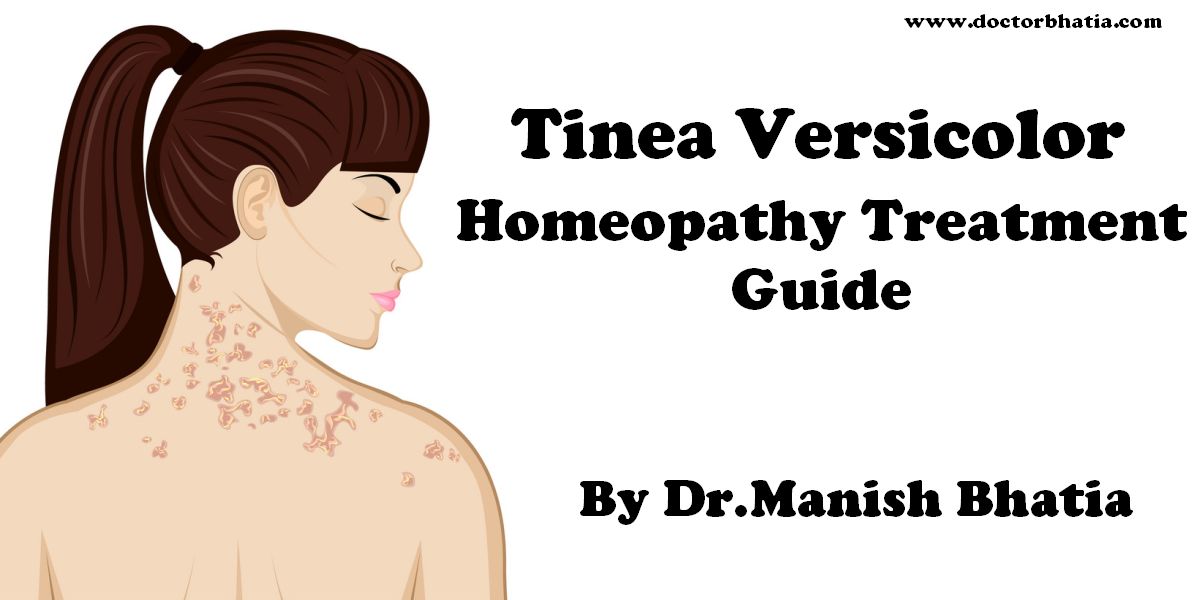Tinea versicolor or pityriasis versicolor is a common skin infection caused by the yeast Malassezia furfur (formerly termed Pityrosporum ovale). This yeast is normally found on the human skin and only becomes troublesome under certain circumstances, such as a warm and humid environment.
Symptoms of Tinea versicolor
The symptoms of this condition include:
- Generally oval or irregularly-shaped spots of 1/4 to 1 inch in diameter, often merging together to form a larger patch
- Occasional fine scaling of the skin producing a very superficial ash-like scale
- Pale, dark tan, or pink in color, with a reddish undertone that can darken when the patient is overheated, such as in a hot shower or during/after exercise
- Sharp border
- Sometimes severe “pin-prick” itching in the affected areas; usually when the person’s body temp is elevated due to exercise or a hot/warm environment, but the person hasn’t started sweating yet. Once sweating begins the “pin-prick” itching stops.
These spots commonly affect the back, underarm, upper arm, chest, lower legs, and neck. Occasionally it can also be present on the face. The yeasts can often be seen under the microscope within the lesions and typically have a so called “spaghetti and meat ball appearance” as the round yeasts produce filaments.
In people with dark skin tones, pigmentary changes such as hypopigmentation (loss of color) are common, while in those with lighter skin color, hyperpigmentation (increase in skin color) are more common. These discolorations have led to the term “sun fungus”.
Prevalence
Tinea versicolor is a common condition. It is estimated that 2 to 8% of the population of the United States has it. This skin disease commonly affects adolescents and young adults, especially in warm and humid climates. It is thought that the yeast feeds on skin oils (lipids) as well as dead skin cells.
Treatment of Tinea versicolor
Treatments for tinea versicolor include:
- Topical antifungal medications – containing either 2.5% selenium sulfide (Selsun shampoo in UK, but not Selsun Blue which contains only 1%) or 2% ketoconazole (Nizoral ointment and shampoo) applied to dry skin and washed off after 10 minutes, repeated daily for 2 weeks[1]. Other topical antifungal agents such as clotrimazole, miconazole or terbinafine are less widely recommended. Additionally, hydrogen peroxide has been known to lessen symptoms, and on certain occasions, remove the problem. Clotrimazole (1%) is also used combined with selenium sulfide (2.5%) (Candid-TV).
- Oral antifungal prescription only medications include 400 mg of ketoconazole or fluconazole in a single dose, or ketoconazole 200 mg daily for 7 days, or itraconazole 400 mg daily for 3-7 days. The single-dose regimens can be made more effective by having the patient exercise 1-2 hours after the dose, to induce sweating. The sweat is allowed to evaporate, and showering is delayed for a day, leaving a film of the medication on the skin.
- Recurrence is common and may be reduced by intermittent application of topical agents (such as tea tree oil) or adding a small amount of anti-dandruff shampoo to water used for bathing.
Homeopathy Treatment for Tinea versicolor
Keywords: homeopathy, homeopathic, treatment, cure, remedy, remedies, medicine
Homeopathy treats the person as a whole. It means that homeopathic treatment focuses on the patient as a person, as well as his pathological condition. The homeopathic medicines are selected after a full individualizing examination and case-analysis, which includes the medical history of the patient, physical and mental constitution, family history, presenting symptoms, underlying pathology, possible causative factors etc. A miasmatic tendency (predisposition/susceptibility) is also often taken into account for the treatment of chronic conditions. A homeopathy doctor tries to treat more than just the presenting symptoms. The focus is usually on what caused the disease condition? Why ‘this patient’ is sick ‘this way’. The disease diagnosis is important but in homeopathy, the cause of disease is not just probed to the level of bacteria and viruses. Other factors like mental, emotional and physical stress that could predispose a person to illness are also looked for. No a days, even modern medicine also considers a large number of diseases as psychosomatic. The correct homeopathy remedy tries to correct this disease predisposition. The focus is not on curing the disease but to cure the person who is sick, to restore the health. If a disease pathology is not very advanced, homeopathy remedies do give a hope for cure but even in incurable cases, the quality of life can be greatly improved with homeopathic medicines.
The homeopathic remedies (medicines) given below indicate the therapeutic affinity but this is not a complete and definite guide to the homeopathy treatment of this condition. The symptoms listed against each homeopathic remedy may not be directly related to this disease because in homeopathy general symptoms and constitutional indications are also taken into account for selecting a remedy. To study any of the following remedies in more detail, please visit the Materia Medica section at Hpathy.
None of these medicines should be taken without professional advice and guidance.
Homeopathy Remedies for Tinea versicolor :
Ars., ars-i., bac., calc., carb-an., carb-v., chrysar., kali-s., mez., nat-a., nit-ac., phos., phyt., psor., sep., sil., sulph., tell., thuj.



